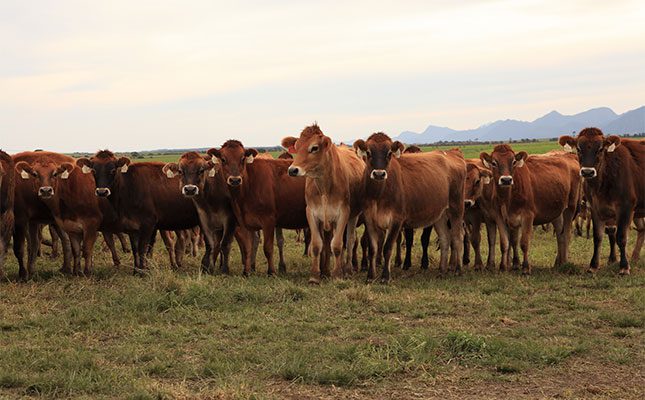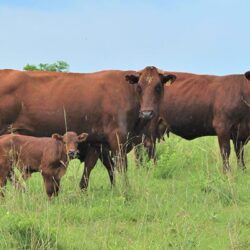Since joining Lactimar farm in the Tsitsikamma in the Eastern Cape in 2016, Dian Landman has managed to greatly improve the profitability and sustainability of this family-owned dairy business. This, despite the region receiving below-average rainfall for the first six years after his arrival and precipitation becoming more irregular.
“The moderate climate of the Tsitsikamma is ideal for dairy production, but climate change is disrupting our normal rainfall patterns and resulting in more dry spells. Where we used to receive about 1 000mm of relatively evenly distributed rain throughout the year, we now get 50mm to 100mm of rain in a few days, followed by weeks of nothing,” says Landman.
He ascribes the improvements in the business’s profitability and sustainability to the solid foundation on which his father, Daan, had left the farm: competent and hard-working staff; the purchasing of two neighbouring farms; the use of technology; and a few production tweaks.
“My father, who retired last year, has a real passion for animals and, thanks to him, we have managed to build one of the best dairy herds in the country,” says Landman.
Landman started out with a Holstein herd, but over time switched to Jerseys and Jersey-Holstein crosses, because these are better suited for pasture-based production systems and produce higher milk solids.
When Landman started at the business, they had 1 600 cows in milk, which have since been increased to 3 400. Roughly 40% of these animals are Jersey cows, 50% Jersey-Holstein crosses, and 10% Holsteins.
“The Holsteins are here on merit and are slowly being phased out. We only produce Holstein-Jersey crosses out of them,” says Landman.
Production
Instead of using one breeding season, about 60% of the cows are inseminated in spring and 40% in autumn.
“We are fortunate that two of our farms have sufficient water to irrigate pastures into the summer, when pasture usually starts to wear off. Having two seasons helps to reduce pressure on staff, pasture and infrastructure. You can just imagine what it would be like to have to artificially inseminate or have 3 400 cows calve all around the same time,” Landman says.
He recently bought 750 AfiCollars to improve heat detection. The collars monitor the movement of the cows and alert farmers when the animals move more or less than usual.
Increased motion is usually a sign that a cow is in heat, whereas reduced motion might indicate an illness or defect. The collars also gather eating and rumination data.
The cows are inseminated as soon as possible after heat is detected, ideally within 12 hours.
Semen from dairy cattle is used during the first three weeks of the insemination season to produce enough dairy heifers to replace 20% of the herd. Hereford semen is used during the rest of the season because of the good demand for these offspring in the beef market.
“We find that the cows that take in the first three weeks are generally genetically superior to those that take later,” says Landman.
Landman and his father import bull semen via Genimex from Viking Genetics in Denmark and more recently from LIC in New Zealand. They have visited the Viking Genetics facility a few times.
“Viking Genetics simply is in a class of its own in terms of the quality of their service, research and information, and the impact of their genetics is well reflected in our herd,” explains Landman.
He started importing the semen of Jersey-Holstein crosses, called KiwiCross bulls, from New Zealand about two years ago. These bulls reportedly allow a producer to maintain hybrid vigour in the offspring of crossbred cattle and give farmers more insight into the percentage of Jersey and Holstein that will be passed on to offspring.
The primary breeding goals at Lactimar, according to Landman, are to produce small-framed cows with good udders and strong legs and feet that can produce a high percentage of butterfat.
Their Jersey milk currently has a butterfat content of up to 5,6% and average protein content of 4,1%, whereas their Jersey-Holstein crosses produce milk with 4,8% butterfat and 3,8% protein. The butterfat content of the Holsteins averages around 44% butterfat and 3,7% protein content.
The ideal weights of the Jerseys are about 420kg, and 460kg for the crossbreeds.
“If a crossbred animal is big, we use Jersey or KiwiCross semen of bulls that have a higher Jersey percentage on the cow to produce smaller offspring. If she is small, we use Holstein or KiwiCross semen of bulls that have a higher percentage of Holstein on the cow,” Landman says.
Cows, on average, are kept for 3,8 lactations.
“We will keep a cow for as long as she produces enough milk with high solids, and does not have recurrent mastitis, reproduction, disease or foot and leg problems. We won’t get rid of a cow because she is old, just as we won’t keep a cow just because she is young,” says Landman.
The Jersey cows and calves are kept separately from the crossbred animals because Landman has noticed that the bigger animals tend to ‘bully’ the smaller ones, which negatively affects the latter’s growth and increases their stress.
The calves are moved to larger camps as they become older and are finally moved to pastures in groups of 100 to 150 once they are about five months old.
Feed management
Landman has an affinity for livestock, but his real interest and passion lies in pasture management. The farm has 880ha of pasture, of which 50% is irrigated and 50% is rainfed, while another 350ha is used for silage production and additional support.
The pastures are planted around the milking parlours to ensure the cows do not have to walk far to graze, whereas silage is planted on land that is further away.
One of the most revolutionary things Landman has done since his arrival at the business is to plant lucerne with chicory and a ryegrass mixture on their drylands.
“Lucerne is not traditionally grown here because people think the region is too wet. However, we have had wonderful results with lucerne. Its inclusion in our pastures has more than doubled the carrying capacity of our new farms.”
The ryegrass and chicory are topped up each year, and the lucerne is re-established every five to seven years. Before replanting lucerne, the remaining lucerne and weeds are destroyed in February, after which annual ryegrass and oats are planted because these produce an abundance of food for the winter.
The oats and annual ryegrass are eliminated in August and new lucerne is then planted in September.
A mixture of perennial ryegrass, hybrid ryegrass, chicory and red clover is planted on the irrigated lands, and these are re-seeded annually after the first rains, starting in March up until the end of May.
Lucerne is also planted in the lands where the irrigation water ‘dries’ up first in summer, which helps to stretch the availability of food from these pastures in summer.
Whereas kikuyu is kept out of the drylands, Landman ‘farms’ it on the irrigated lands.
“Kikuyu will outcompete other crops on dryland, but when enough water is available for all the crops, it can be used to bring volume to the pasture. Our crop mixtures overshadow the kikuyu, forcing it to switch from a sprawling to an upright growing position. So, instead of making lots of indigestible runners, it produces more leaves.”
The kikuyu is ‘throttled’ with a contact herbicide before the irrigated lands are reseeded to prevent it from overshadowing and negatively impacting the germination and growth of the planted mixture.
“We don’t want to completely destroy the kikuyu because it serves as a cover crop that helps to suppress other weed species, bulk up the pasture, reduce evaporation and protect the soil against erosion,” says Landman.
Ryegrass forms the foundation of rotation decisions, with the main aim to graze a pasture when the ryegrass is in the 2,5 to three leaves stage. This is because ryegrass has the highest protein, energy and nutritive value, and as such helps to boost milk production volumes, he explains.
In summer, the warm temperatures could shorten grazing intervals to about 20 days, whereas the cold can lengthen intervals to 40 days in winter.
Pastures that are grazed for the first time, after planting, are cut down with a disc mower before grazing. Landman says this prevents the cows from pulling the new seedlings out of the ground, while also serving as a mechanical means to destroy weeds.
Silage
For silage production, oats and triticale are planted on 150ha of the surplus lands and maize on the rest.
“My father rather planted sorghum than maize as it is more expensive to plant, which means that the cost per ton gets very expensive if you have a dry year and the harvest is poor. I, however, prefer maize because it has a much higher nutritional value and produces higher tonnage. In normal years, the cost per dry ton works out much cheaper than with sorghum,” says Landman.
Silage is given to the animals in January if dry conditions result in shortages, and from April when pastures must be reseeded until June, once the reseeded pastures are ready to be grazed.
The silage is mixed in a feed mixer with lucerne, citrus pulp, canola oil cake and straightrun maize meal, after which it is supplied to the cows on the pastures.
Landman has improved silage quality and reduced spoilage by building seven silage bunkers.
“In the past the silage was packed on the ground in heaps of 120t to 150t. With the bunkers we can stack more than 800t in a heap, which means that we use four to five times less plastic to cover the silage. The biggest benefit is that it is easier to compact the silage in the bunkers, which results in lower spoilage due to anaerobic conditions,” says Landman.
The silage is inoculated to reduce dry matter losses by improving fermentation efficiency and reducing spoilage, and shear grabs are used to ‘cut out’ the silage from the heap, which prevents spoilage in the remaining heap.
Landman has also introduced more frequent cutting for baled grass silage to ensure the focus is on quality and not just quantity.
The Afimilk Herd Management programme is used to monitor and keep record of the animals, with each cow being fitted with a radio frequency identity tag that is scanned as she moves into the milking parlour.
Rations fed to the animals in the parlour are regularly adapted, based on individual parameters, such as the age of each cow, volume of milk produced, phase of lactation cycle and body weight as measured in the milk parlour.
The smaller cows, which produce about 6 000ℓ per lactation, receive a target of 1,6t tons of concentrates and 12t to 12,5t of dry matter from pastures per year, whereas the larger cows, averaging 7 500ℓ per lactation, receive 2,1t of concentrate and 12,5t to 13t of dry matter from pasture. The remainder of their diet comes from the silage.
Landman‘s seven silage bunkers allow him to use five times less plastic than was needed to cover the silage in heaps on the ground.
Technologies
Five years ago, Landman began participating in the Trace & Save programme, started by Woodlands Dairy. The programme measures indicators of sustainability, such as soil, water, carbon and nutrient usage, biodiversity and animal welfare, allowing farmers to track changes on their farms pertaining to sustainability.
The programme also gives advice on ways in which farmers can improve their sustainability. Landman and his production adviser use these recommendations to help formulate fertilisation decisions for each pasture.
“I am fortunate that my father had the foresight to start using chicken litter to fertilise the lands before I came to the farm, and this has greatly improved our soil quality and fertility. Transporting chicken manure to the farm has become expensive, therefore it has been replaced with compost made on contract for us from manure in our manure pit. We also spray slurry onto the pastures as needed,” Landman says.
He equipped his tractors with GPS and track control at a cost of around R200 000, but these systems repaid themselves in less than a year thanks to the efficiencies they brought.
The systems have reduced wastage and saved cost by reducing overlapping of tracks during seeding and fertilisation, and it has allowed Landman to apply fertiliser and lime at variable rates, instead of making a blanket application where some areas are over- and others are under-supplied.
The use of variable rate application is not only improving fertilisation efficiency but increasing uniformity, making the pastures easier to manage.
He estimates that the use of organic fertiliser, conservation tillage, mixed cropping, variable rate applications and track control have helped to reduce their synthetic fertiliser usage by 35% to 40%.
Landman installed a 200kW solar system with a battery capacity of 640kWh in December last year to alleviate the impact of load-shedding on production. The system can supply the one farm with four hours of power during peak time and six hours off-peak.
Ice banks are used to cool the milk rapidly after it was milked, as this is more energy efficient than having to cool a whole tank.
Strong workforce
Landman says the business simply would not have been as successful as it is if it was not for his management team and staff members. The farm employs 80 people full-time and has a management team consisting of 15 people.
Instead of forcing people to work everywhere on the farm, workers are encouraged to specialise in fields that interest them. The workers also receive regular training to improve their skill levels.
Landman’s wife, Dinel, who is an accountant, in particular made a huge contribution to the farm’s success by taking over the financial management of the farm.
“We used independent financial managers to do our books in the past, and this often meant that you only gained valuable financial insights six months after you have submitted your financial statements for the year.
“With Dinel managing the finances, we now know exactly how much we are spending on what, and she can alert me when spending on things are getting out of control, or when we have surpluses that can be used to cover future expenses, for instance by buying additional silage or surplus food in case there is a drought,” adds Landman.
Email Dian Landman at landman@lactimar.co.za.




